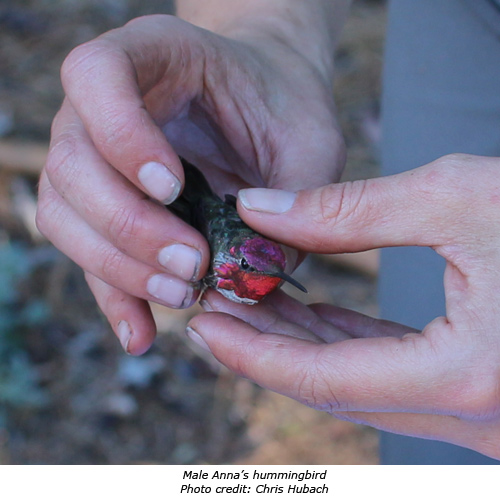
This posting is a summary of the birds captured June 20 through July 15, 2014. 752 birds were netted, which includes both new (previously unbanded) and recaptured birds, and brings the total to 1226 birds netted during the 2014 season. The increase in captures is due to the surge of fledging hatch year birds leaving their nests, and the wave will likely continue through July. White Wolf is about one week behind the other sites due to its high elevation. Common species of hatch year birds caught include dark-eyed juncos, yellow-rumped warblers (Audubon’s race), red-breasted sapsuckers, Lincoln’s sparrows, song sparrows, orange-crowned warblers, brown creepers, golden-crowned kinglets, and house wrens. 52 different species were netted, and highlights for the team include a pine grosbeak at White Wolf, Lawrence’s goldfinch in Hodgdon Meadow, Williamson’s sapsucker at Gin Flat, and oak titmouse at Big Meadow. Also, nine out of ten GPS transmitters have been deployed on after hatch year black-headed grosbeaks in Hodgdon Meadow. Fingers crossed, we hope to see some of these birds return to nest next year so we can remove the transmitters and learn more about the bird’s movements through migration (see previous blog post with more information).
The banding day ends six hours after it began, and the tired researchers pack up and head back to camp. Over lunch, the crew discusses the birds they saw that day – which species stood out, their personal favorites, and tricky plumage identifications - with detours on other subjects like snakes and wildflowers encountered that day. At dusk it’s early to bed so the researchers can rise early with the birds that are after the proverbial worm.
|
Site |
New bands |
Recaptures |
|
Big Meadow |
58 |
7 |
|
Hodgdon Meadow (lower site) |
87 |
13 |
|
Hodgdon Meadow (upper site) |
94 |
26 |
|
Crane Flat |
158 |
35 |
|
Gin Flat |
129 |
37 |
|
White Wolf |
78 |
18 |
52 Species Captured (in taxonomic order):
- Hummingbirds: Anna’s hummingbird (Calypte anna), calliope hummingbird (Stellula calliope), rufous hummingbird (Selasphorus rufus)
- Woodpeckers: Williamson’s sapsucker (Sphyrapicus thyroideus), red-breasted sapsucker (Sphyrapicus ruber), downy woodpecker (Picoides pubescens), hairy woodpecker (Picoides villosus), white-headed woodpecker (Picoides albolarvatus)
- Flycatchers: olive-sided flycatcher (Contopus cooperi), western wood-pewee (Contopus sordidulus), Hammond’s flycatcher (Empidonax hammondii), dusky flycatcher (Empidonax oberholseri), pacific-slope flycatcher (Empidonax difficilis)
- Vireos: Cassin’s vireo (Vireo cassinii), warbling vireo (Vireo gilvus)
- Steller’s jay (Cyanocitta stelleri)
- Tits: mountain chickadee (Poecile gambeli), oak titmouse (Baelophus inornatus), bushtit (Psaltriparus minimus)
- red-breasted nuthatch (Sitta canadensis)
- brown creeper (Certhia americana)
- Wrens: Bewick’s wren (Thryomanes bewickii), house wren (Troglodytes aedon), golden-crowned kinglet (Regulus satrapa)
- wrentit (Chamaea fasciata)
- Thrushes: hermit thrush (Catharus guttatus), American robin (Turdus migratorius)
- Warblers: orange-crowned warbler (Oreothlypis celata), Nashville warbler (Oreothlypis ruficapilla), MacGillivray’s warbler (Geothlypis tolmiei), yellow warbler (Setophaga petechia), yellow-rumped warbler (Audubon’s race) (Setophaga coronata), black-throated gray warbler (Setophaga nigrescens), hermit warbler (Setophaga occidentalis), Wilson’s warbler (Cardellina pusilla)
- Sparrows: green-tailed towhee (Pipilo chlorurus), spotted towhee (Pipilo maculatus), chipping sparrow (Spizella passerina), fox sparrow (Passerella iliaca), song sparrow (Melospiza melodia), Lincoln’s sparrow (Melospiza lincolnii), dark-eyed junco (Oregon race) (Junco hyemalis)
- Western tanager (Piranga ludoviciana)
- black-headed grosbeak (Pheucticus melanocephalus)
- Lazuli bunting (Passerina amoena)
- Blackbirds: red-winged blackbird (Agelaius phoeniceus), Bullock’s oriole (Icterus bullockii)
- Finches: pine grosbeak (Pinicola enucleator), purple finch (Carpodacus purpureus), Cassin’s finch (Carpodacus cassinii), pine siskin (Spinus pinus), lesser goldfinch (Spinus psaltria), Lawrence’s goldfinch (Spinus lawrencei)
